An Auckland developer has cut his waste by 90%, and has managed to complete construction of eight terrace houses without the use of a skip.
Developer Nigel Benton would normally send around eight full-size two-tonne skips to landfill during construction but he changed his ways after reading about the work Auckland Council’s senior waste planning adviser Mark Roberts in a building magazine two years ago.
Benton’s subsequent collaboration with Auckland Council, waste management firm Junk Run and Unitec Institute of Technology on his build at 40 Titirangi Road, in New Lynn, has reduced the amount of waste that is being diverted to landfill.
Waste from a development like the one at 40 Titirangi Road would normally amount to 16 tonnes. In past developments, trades people had been known to dump everything from single-use coffee cups to perfectly good reusable materials into on-site skips.
Start your property search
Roberts told OneRoof that he had been looking for a site to test a non-skip build when Benton contacted him. The Titirangi Road site was a bonus because it showed that waste minimisation could work even on a very tight multi-unit build.
Roberts and Benton worked with associate professor Terri-Ann Berry, at Unitec’s school building construction, and Junk Run’s construction and commercial waste manager, David Knight, on a waste management plan for the build.
Wood and metals were to be separated into 660-litre bins, and soft and hard plastics into large bags. Hazardous wastes such as sealants and solvents were kept separate as were paint tins.
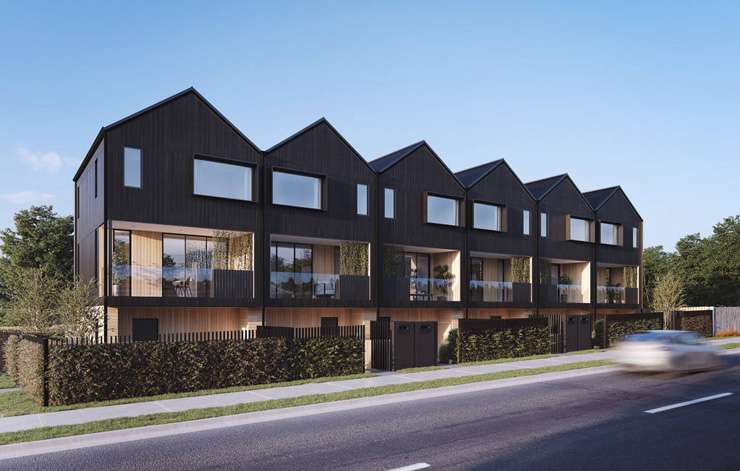
An artist's impression of Forty Titirangi, in New Lynn, Auckland. Photo / Supplied
Berry made sure the bins were labelled clearly and included pictures. “It’s much easier for the guys on site if they see a picture. They’ll say, ‘Oh, yeah, it's that type of waste, I'll put it in this bin.’ They’re not going to read through a list of stuff,” Berry said.
The big challenge for Benton was changing the tradies’ behaviour, and the first few days on site involved quite a bit of head-scratching. “In those first few days, you’d pick something up and think, ’Oh, I’ve got no bin to put it in. What do I do now?’”
Fortunately, Benton’s builder, Caleb Douglas, of Windsor Construction, got it. If not, it could have been the end of the project. Once Benton and Douglas got into the swing of it, they found that the new system wasn’t all that much harder than using the skips. “Now you carry it out and instead of throwing it in the bin, you put it in the bag or in the recycling bin instead,” Benton said.
Knight added: “Nigel had a couple of issues with certain tradesmen’s behaviour. They were doing what they've always done, which is not caring and being lazy, and just throwing their crap everywhere – the kind of behaviour that’s been going for 20-plus years.
“But because you've got the plan and you've got that visual representation, you can easily tell who's not abiding by it, because you can tell what the material is. If there’s an electrical wire in the timber bin, you know that's the electrician. So you can hit them up and say, ‘hey, hang on a minute’. The new guys on site loved the idea and ran with it. And now they're saying that they would never do anything different.”
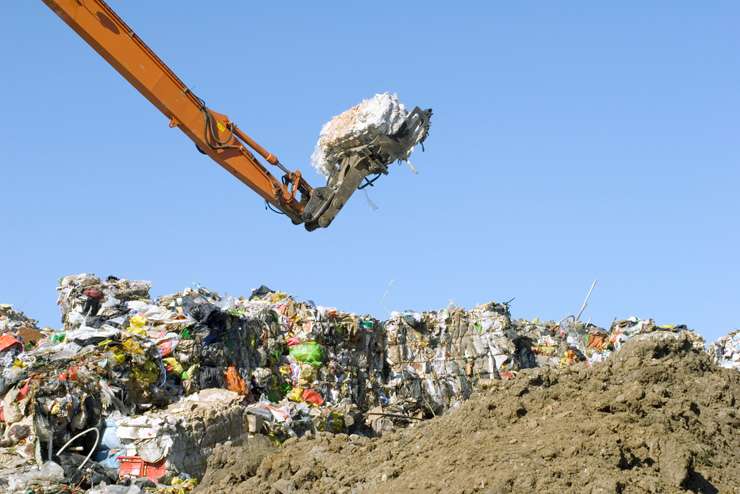
A landfill site. An estimated that $34,000 of materials are wasted in every house built in New Zealand. Photo / Getty Images
The problem of building waste in New Zealand is huge. The average house build produces 4.5 tonnes of waste. If a house is demolished first, add another 26 tonnes, said Roberts.
Construction and demolition sites currently send 568,935 tonnes a year to landfill, which is twice that of household refuse collected throughout Auckland.
Multiple factors feed into the wastefulness of construction in Auckland and other parts of the country, according to AUT University’s Dr Jeff Seadon, senior lecturer in the School of Future Environments.
Successful examples in construction and demolition waste management involved a combination of legislation, landfill levies, development of mature landfill diversion markets, an efficient platform for waste exchange and a scheme to give credit for undertaking site waste management, Seadon concluded in a report for Auckland Council looking at the impact mandatory site plans would have in Auckland if a bylaw was passed.
The council has construction and demolition waste as a priority in its latest Waste Management and Minimisation Plan. Currently Auckland builders are not required to submit a mandatory waste management plan to council. Both Hamilton and New Plymouth’s councils have introduced by laws that require waste management plans.
Seadon, AUT colleague Ala’ Aladwan and Winstone Wallboards’ manager future Kevin Golding found in their research that Auckland’s construction and demolition sector was very wasteful compared to international examples.

Auckland Council’s senior waste planning adviser Mark Roberts: "Even before materials hit the site, architects can do more to reduce waste." Photo / Supplied
Germany and the Netherlands reuse or recycle around 80% of their construction and demolition waste. Denmark has exceeded 90.5%.
Another issue in Auckland and in many other parts of New Zealand is that waste levies are low by international standards, which does not incentivise the industry to reduce waste.
In Sydney, for example, the waste levy ranges between $120 and $180 per tonne, said Knight. Here it was $10 a tonne until recently and now $20.
“That’s the reason there’s no massive innovation,” Seadon said. “Because the waste levy is so cheap and the majority of skip companies in Auckland and around the country are owned by the same people who own the landfills. So there’s no incentive to do something with that waste.” The Government has gazetted to increase it progressively to $60 per tonne in July 2024.
The AUT/Winstone research highlighted poor handling of materials on building sites. The report concluded that 29% of timber, plasterboard and polystyrene that arrives on site in New Zealand is wasted. That adds a burden on the environment, but also escalates the cost of building, which is passed on to customers.
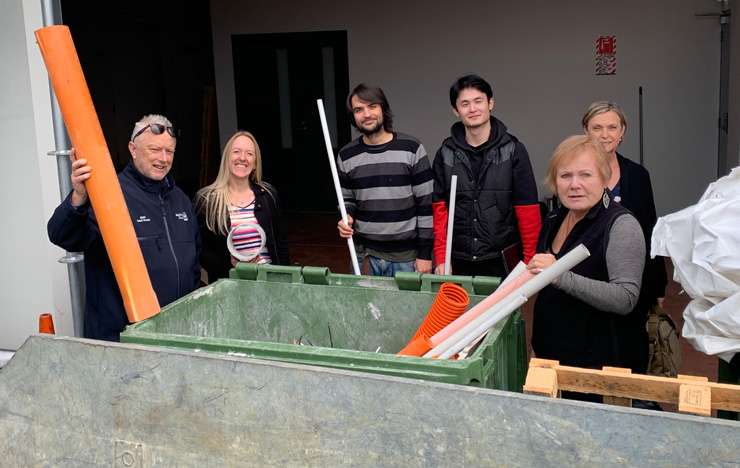
Roberts, far left, and Unitec associate professor Terri-Ann Berry, second from left, with students and team members involved in the project. Photo / Supplied
Seadon estimated that $34,000 of materials are wasted in every house built in New Zealand. That’s debt on homeowners’ mortgages for materials that they would never see or get use out of, Roberts said. “This material is lost through poor handling and poor storage. It’s not treating materials with the respect that they deserve.”
He concluded that a programme to develop and implement mandatory site waste management plans in Auckland was feasible, desirable and would work to reduce construction and demolition waste across the city. A programme would also enable the council and the construction sector to gain valuable information on waste quantities and flow.
In Benton’s four decades in building and development, he has seen the amount of waste balloon. “Merchants and suppliers have plastic over everything. They wind it around everything about a hundred times,” he said. “That’s been the biggest learning for me. The volume of plastic that’s in the industry, it’s recyclable but no one knows. Nothing’s publicised as to where it goes. If I hadn’t done this, I honestly would have no idea where it (went).”
The answer is that in most cases the soft plastic from building sites all goes to landfill, despite being recyclable.

Hard plastics from the site were placed into large bags. Photo / Supplied
Benton estimated that he had diverted around 12 tonnes of waste from landfill for reuse or recycling. No skips has meant he has avoided paying for locals’ fly tipping, as is often the case during construction.
Waste from the site at Forty Titirangi has found its way to dozens of different community and commercial recycling operations and projects, mostly via Junk Run, which picks up and delivers directly to the ultimate end user.
Junk Run has been diverting construction and commercial waste away from landfill for more than a decade and has multiple relationships with social enterprise programmes, charities, tiny home builders, hobbyist workshops, man sheds, and other schemes, says Knight. “So any type of little material that other people might see as waste we see it as, as a resource.
And we make sure that that resource gets a second life.”
Reusable wood is delivered to Green Gorilla, or the Waitākere Refuse and Recycling Transfer Station. If it can’t be recycled it’s burned in the furnaces at a cement factory.
A big issue with the current building materials supply crisis was the amount of plasterboard offcuts and insulation materials being sent to landfill, Knight said. “A lot of people just want to patch up the bathroom, so why are we throwing these things into the landfill.”
Even if not reused, plasterboard offcuts contain gypsum, and could be used as fertiliser.
Some materials are returned to the manufacturer. That includes Marley offcuts and Nuralite roofing membrane off cuts.
Benton would like to see more manufacturers take leftover materials back. “I would love to see a time when all manufacturers and merchant supply companies were responsible for the recycling of the products they produce and sell. There are some really great ones but still so many that don’t care.”
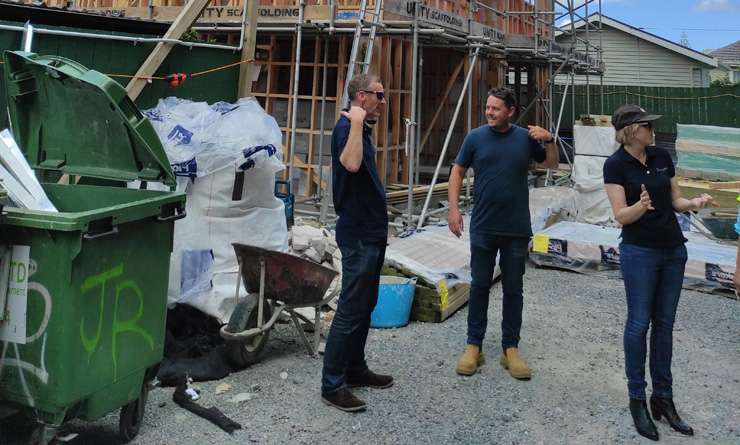
The construction crew came quickly around to the new way of handling waste materials. Photo / Supplied
Hard plastics from the site were placed into large bags. Photo / Supplied
Even though he doesn’t have to pay for skips, the cost has not been reduced. Benton has to pay Junk Run to collect the recycling bins.
Recycling of building materials in New Zealand has a long way to go before it becomes a circular economy where builders can sell their waste, Berry said. But it will happen.
When it does, the industry will be incentivised to reduce the $100m a year spent on tipping fees by the construction and demolition industries.
The mindful approach to waste has resulted in indirect cost savings at Forty Titirangi. Separating waste on site has helped to highlight problem materials.
Benton would be more careful about choosing those materials again and has discussed this with his architect. For example, he became aware during the build that the James Hardie RAB board as well as its tile and slate board used on site were wasteful.
“Hardie have been very unhelpful and said it goes to clean landfill. Mark Roberts found a company with a crusher. We took [the RAB board off cuts] there and they crushed it into small bits. We are mixing this with the drive hard fill. This will be compacted and the concrete will be poured over the top," he said.
“These companies should have to have a means of recycling a product they produce."
Benton himself delivers the plastics from site to Unitec’s engineering department where they’ve become the basis of a number of studies being conducted by Berry’s team. “I have many final year project students who like to do an environmental project,” Berry said.
“Around 2015, we started looking in earnest at problems with (construction and demolition) waste. A lot of my students already work in construction and demolition, so they were able to do some auditing on site for me.”
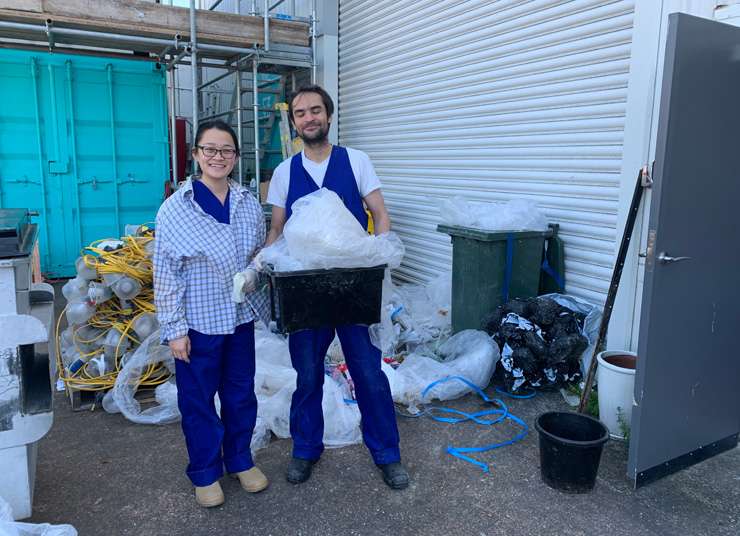
Students from Unitec have been using the excess plastics from the site in their studies. Photo / Supplied
That highlighted problem materials, as had the Forty Titirangi build, said Berry. “We are looking at two things. Firstly, can we encourage suppliers to reduce the amount of plastic that they're supplying in terms of packaging? Or can we offer different materials that don't need unnecessary amounts of plastic?”
The department is particularly interested in the lifecycle of a building site and the types of plastics used at different stages from purchasing until it leaves the building site. It can be logistically difficult to keep plastic clean enough on a building site so that it can be recycled. This research is helping with that.
“Once we have separated and analysed (the material) and we know basically what we're dealing with we decide, depending on the quality, where we're going to send it. I would say on a weekly basis, we're connecting up with new companies who are saying, ‘we can take this waste’, or, ‘can you help us with this waste situation’. So it really is evolving and ongoing research.”
Once the researchers are finished, the plastics then find their way to companies such as SAVEboard, FuturePost and Astron, which can recycle them into saleable products.
For example, the soft plastics are picked up by SAVEboard and converted into wall boards at its Hamilton plant. Some of those boards are going back to Benton’s site to be used as hoardings. When they deteriorate, the plastic in them can be recycled again.
The Forty Titirangi project has highlighted how much can be reduced long before materials are ordered, said Roberts “Even before materials hit the site, architects can do more to reduce waste. For example, designing to fit standard dimensions of materials. Work needs to be done on that.”
At the other end of a build, better systems to get materials to their destinations need to be worked on, said Roberts. “In the long term, we're going to have to think very carefully about how we encourage companies to transport their waste, because we don't want to create a bigger issue by everybody driving small amounts of waste all over the country to get them recycled. That isn't a solution.
“There's a lot to it. It's part of the bigger picture. But it's a start. And it's also just demonstrating that there is capability and it can be done.”
















































































